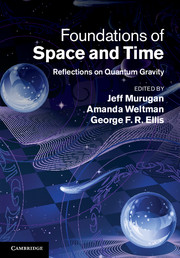Book contents
- Frontmatter
- Contents
- List of contributors
- 1 The problem with quantum gravity
- 2 A dialogue on the nature of gravity
- 3 Effective theories and modifications of gravity
- 4 The small-scale structure of spacetime
- 5 Ultraviolet divergences in supersymmetric theories
- 6 Cosmological quantum billiards
- 7 Progress in RNS string theory and pure spinors
- 8 Recent trends in superstring phenomenology
- 9 Emergent spacetime
- 10 Loop quantum gravity
- 11 Loop quantum gravity and cosmology
- 12 The microscopic dynamics of quantum space as a group field theory
- 13 Causal dynamical triangulations and the quest for quantum gravity
- 14 Proper time is stochastic time in 2D quantum gravity
- 15 Logic is to the quantum as geometry is to gravity
- 16 Causal sets: discreteness without symmetry breaking
- 17 The Big Bang, quantum gravity and black-hole information loss
- 18 Conversations in string theory
- Index
- References
8 - Recent trends in superstring phenomenology
Published online by Cambridge University Press: 05 August 2012
- Frontmatter
- Contents
- List of contributors
- 1 The problem with quantum gravity
- 2 A dialogue on the nature of gravity
- 3 Effective theories and modifications of gravity
- 4 The small-scale structure of spacetime
- 5 Ultraviolet divergences in supersymmetric theories
- 6 Cosmological quantum billiards
- 7 Progress in RNS string theory and pure spinors
- 8 Recent trends in superstring phenomenology
- 9 Emergent spacetime
- 10 Loop quantum gravity
- 11 Loop quantum gravity and cosmology
- 12 The microscopic dynamics of quantum space as a group field theory
- 13 Causal dynamical triangulations and the quest for quantum gravity
- 14 Proper time is stochastic time in 2D quantum gravity
- 15 Logic is to the quantum as geometry is to gravity
- 16 Causal sets: discreteness without symmetry breaking
- 17 The Big Bang, quantum gravity and black-hole information loss
- 18 Conversations in string theory
- Index
- References
Summary
We briefly review basic aspects of string theory and broadly discuss possible phenomenological scenario. We then focus on vacuum configurations with intersecting and/or magnetized unoriented D-branes. We show how a TeV-scale string tension may be compatible with the existence of large extra dimensions and how anomalous U(1)s can give rise to interesting signatures at LHC or in cosmic rays. Finally, we discuss unoriented D-brane instantons as a source of non-perturbative effects that can contribute to moduli stabilization and SUSY breaking in combination with fluxes. We conclude with an outlook on holography and directions for future work.
Foreword
More than 40 years after its original proposal, there is no experimental evidence for string theory or, else, a satisfactory – possibly holographic – description of the QCD string is not yet available.
Still, the Veneziano model predicts a massless vector boson in the open string spectrum and the Shapiro-Virasoro model a massless tensor boson in the closed string spectrum. These two particles can naturally be associated with the two best known forces in Nature: gravity and electromagnetism. After GSO projection, supersymmetry then guarantees the presence of massless fermions.
Moreover, string theory makes a definite – albeit incorrect – prediction for the number of space-time dimensions: 26 for bosonic strings, 10 for superstrings. This basic fact led to many so-far unsuccessful attempts to get rid of the undesired extra dimensions. Calabi-Yau and orbifold compactifications, non-geometric Gepner models are the most famous examples.
Information
- Type
- Chapter
- Information
- Foundations of Space and TimeReflections on Quantum Gravity, pp. 140 - 163Publisher: Cambridge University PressPrint publication year: 2012
